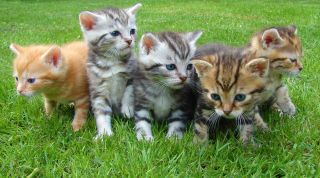Animal Behavior
The Hidden and Not-So-Hidden Social Lives of Cats
Cat expert Sarah Brown's new book will help make you "fluent in feline."
Posted October 16, 2023 Reviewed by Michelle Quirk
Key points
- Based on the latest science and great stories, "The Hidden Language of Cats" shows who they truly are.
- This new book covers the many ways in which cats communicate with each other and with people.
- Cats can live both in social groups and as solitary individuals and easily change from one to the other.
“At last, a brilliant voice to give cats the recognition they deserve." –Brian Hare and Vanessa Woods
Cats are fascinating animals. I'm always eager to learn what research is revealing about their hidden and not-so-hidden lives and the often mysterious ways in which they negotiate their own social worlds and their relationships with humans.1 These are among the reasons I was thrilled to learn of a new book by cat expert Dr. Sarah Brown called The Hidden Language of Cats: How They Have Us at Meow. In this wide-ranging discussion of cat behavior that will help make you "fluent in feline," we learn about different forms of communication—cat language—including vocalizations, tail signals, scents, rubbing, and ear movements and that the cat's meow is a feline invention for conversing with us.

Here's what Sarah had to say about her extremely important, myth-busting book. Although intriguing and somewhat mysterious, cats aren't as asocial as some people claim they are. In fact, they're extremely adaptable and actually have plenty to say for themselves.
Marc Bekoff: Why did you write The Hidden Language of Cats?
Sarah Brown: During my studies of and work with cats over the last 30 years, I’ve often felt they were rather misrepresented, frequently described as aloof, inscrutable, or uncommunicative, particularly in comparison with our other best friends, dogs. In reality, cats have a whole host of social signals that they use both with one another and with us humans. It’s all just a bit more subtle than with dogs. So, my aim was to show, by exploring all the wonderful scientific research on cat behavior, the many ways in which cats communicate, hopefully enabling readers to better understand the cats in their lives.

MB: How does your book relate to your background and general areas of interest?
SB: Having studied zoology as an undergraduate, I was fascinated by animal behavior and began studying cats in the late 1980s when I embarked on my doctorate. Focusing my studies on two colonies of neutered feral cats, I discovered some intriguing new scientific facts about the social interactions within these groups, particularly how they used tail signals and rubbing in their day-to-day lives. After my Ph.D., I continued to work with cats, and have done ever since, keeping up with the science and working as a cat behavior counselor and a consultant for the cat toy industry and carrying out research for cat rescue organizations in the UK, as well as writing books about cats.
My book pulls together all the science, both older and more modern, on cat communication. It also includes stories from my work with cats, right from the earliest farm cats that I studied, to the cats I worked with in shelters, and some of my own cats, too.
MB: Who is your intended audience?
SB: Anyone who has a cat or loves cats and is interested in learning more about how cats communicate, and about how best to interact with them.
MB: What are some of the topics you weave into your book and what are some of your major messages?
SB: I discuss the varied forms of communication cats use and about how amazing this is considering they are descended from a solitary wildcat ancestor that relied mainly on scent for communication. These wildcats rarely met one another apart from to breed, and so long-distance methods of communication by scent were ideal. As cats became more domesticated, they had to adapt to living in close quarters with other cats and with people, too, so they found more visual and tactile ways to communicate. I talk about the behaviors I recorded cats using in their day-to-day interactions with one another such as Tail Up, which is a good indicator of friendly intentions when one cat approaches another. This often leads to rubbing between cats, an intriguing cat behavior that I explore in more detail. Cats use these same behaviors when interacting with people, too.

For humans, the preferred method of communication tends to be talking. Cats seem to have worked this out and have developed their iconic meow especially to communicate with people—they rarely meow to one another apart from the little mews from kittens to their mothers. I explore meows in detail—What are the different types? Why are they so hard to ignore? And do we really understand what they mean?
I also take a look at the different ways in which humans interact with cats. One of my most important messages is for people to be very conscious of the ways in which they interact with cats. Try and let the cat lead the interactions, bear in mind how cats prefer to be petted, and notice from their body language when they have had enough. Hopefully people’s conversations with cats will be much longer and more rewarding as a result!
MB: How does your book differ from others that are concerned with some of the same general topics?
SB: My book combines a detailed look at the many scientific discoveries of cat behavior (both my own work and that of other researchers) with stories of some of the cats behind this science, plus other cats I have had the pleasure of working with and living alongside over the years. It also contains simple, light-hearted line drawings of cats being cats. I hope this combination of science, illustrations, and meeting cats such as Hissing Sid, one of my feral farm cats, helps make the science feel more accessible.
MB: Are you hopeful that as people learn more about the language of cats they will treat them with more respect?
SB: Very much so. As people realize how well cats have actually learned to communicate with one another and with us, even though their language is less obvious than that of dogs, I hope that cats will lose their reputation for being cool or aloof. They are far from it, and often work much harder than humans at trying to get their message across. Their ability to live both in social groups or as solitary individuals and to easily change from one to the other shows an amazing adaptability, one which deserves some serious respect!
References
In conversation with Dr. Sarah Brown. Sarah gained her Ph.D. on the social behavior of neutered domestic cats while working at the Anthrozoology Institute at the University of Southampton in the United Kingdom. She has since worked as an independent cat behavior counselor and as a consultant for the cat toy industry, and has conducted research for and worked with several UK animal charities. Sarah's other books include The Cat: A Natural and Cultural History and The Behaviour of the Domestic Cat, 2nd edition, and she contributed to The Domestic Cat: The Biology of Its Behaviour, 3rd edition.
1. If We Weren't Around, Would Cats Fare Better Than Dogs?; "The Cat's Meow": A Novel View of Who Cats Are and What They Need; Why Consenting Cats Are Happier Cats; How to Tell if Cats Are Playing or Fighting; Cats Deserve to Be Happy—Here's How to Enrich Their Lives; Are Some Cats Psychopathic, or Are They Just Being Cats?; Are Cats More Socially Inept Than Dogs?; Do Our Dogs Really Love Us More Than Our Cats Do?; Dogs and Cats: Their Brains, Faces, Blinking Eyes, and Us; Dogs Are Not Smarter Than Cats, and More: A Media Muddle; Dogs, Cats and Scapegoats: Messes We Make With Companions; The Inner Life of Cats Reveals Fascinating Feline Secrets.




